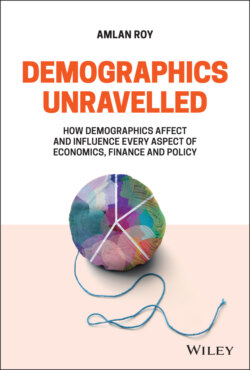Demographics Unravelled

Реклама. ООО «ЛитРес», ИНН: 7719571260.
Оглавление
Amlan Roy. Demographics Unravelled
Table of Contents
List of Tables
List of Illustrations
Guide
Pages
Praise for Demographics Unravelled
Demographics Unravelled. How Demographics Affect and Influence Every Aspect of Economics, Finance and Policy
About the Author
Acknowledgements
Selected Abbreviations
Preface
Notes
Chapter 1 Introduction
1.1 Recasting Demographics
1.2 Effects and Implications of Demographics
Notes
Chapter 2 Core Data: Past, Present, and Future
2.1 Economic History and the History of Global Population Trends
2.2 Core Demographic Variables: Data, Analysis, and Some Observations
2.2.1 Population Size and Population Growth
2.2.2 Ageing Populations
2.2.3 Life Expectancy Increases
2.2.4 Total Fertility Rates
2.2.5 Dependency Ratios
2.2.6 Gender Ratios
2.2.7 Age Structure and Population Pyramids
2.2.8 The Demographic Transition Model
2.3 The Role of Migration
2.4 Urbanisation
2.5 Small Nation-States: Demographics
2.6 Changing Longevity—Metrics Need Changing
2.7 Changing Social and Individual Behaviour
2.8 Multiple Generations
2.9 Conclusion
Notes
Chapter 3 Demographics and Macroeconomics
3.1 Demographics and Economic Growth
3.2 The “Demographic Dividend” and GDP per Capita Growth
3.3 Inflation
3.4 Debt, Deficits, and Fiscal Sustainability
3.5 Demographics, Monetary Policy, and Interest Rates
3.6 Demographics and Unemployment
3.7 Demographics, Capital Flows, and Current Account
3.8 Conclusions
Notes
Chapter 4 Demographics and Asset Prices
4.1 Theories of Life-Cycle Consumption, Savings, and the Permanent Income Hypothesis. 4.1.1 Life-Cycle Consumption Theory
4.1.2 Permanent Income Hypothesis
4.1.3 Consumption, Savings, and Intertemporal Loans: Pioneer Paul Samuelson
4.2 How Demographics Influences Equity Prices and Markets
4.3 Will There Be an Asset Market Meltdown When the Baby Boomers Retire?
4.4 Demographic Changes and Interest Rates (Bond Yields)
4.5 Demographics and Risk Premiums
4.6 Asset Holdings and Age
4.7 Demographics and Equity Sectors
4.8 Demographics and Real Estate
4.9 Demographics and Commodities
4.10 Conclusions
Notes
Chapter 5 Health and Longevity
5.1 Health Issues, Expenditures, and Measures
5.1.1 Health Expenditures
5.1.2 Global Health Security
5.1.3 Global Burden of Disease
5.1.4 Health in Emerging Countries
5.2 Longevity
5.2.1 Increases in Life Expectancy and Conditional Life Expectancy
5.2.2 Life Expectancy vs. Healthy Life Expectancy
5.2.3 DALYs and Their Causes
5.2.4 Longevity and Mortality: More Than Just Births and Deaths
5.2.5 Longevity Risk and the Uncertain Future of Longevity
5.2.6 Longevity Forecasting Models: Countries and Regions
5.2.7 Short Summary of Longevity Models
5.2.8 Annuities as a Longevity Risk Management Tool
5.2.9 Other Longevity Risk Management Tools and Instruments
5.3 Conclusions
Notes
Chapter 6 Pensions and Retirement
6.1 A Brief History of Social Security and Pensions
6.1.1 Pre–Social Security
6.1.2 Committee on Economic Security
6.2 Evaluating Pension Systems: Indicators and Cross-Country Comparisons
6.3 Evaluating Age-Related Pension Expenditures Across Countries
6.4 Pensions and Pension Systems: The Experts
6.5 Pensions, Asset Allocation, Investments, and Capital Markets
6.6 Pensions and Corporate Finance/Equity Prices
6.7 The Future of Retirement and Conclusions
Notes
Chapter 7 Quality of Life, Gender, Governance and Sustainability
7.1 Utility Theory, Social Welfare, and Happiness
7.2 Quality of Life: Human Development Index (HDI)
7.3 Gender and Governance
7.4 Corruption and Transparency
7.5 Sustainability and Climate Change
7.6 Politics and Geopolitics
7.7 Conclusion
Notes
Chapter 8 Summary and Conclusions
Notes
Index
WILEY END USER LICENSE AGREEMENT
Отрывок из книги
“This book is a fascinating marshalling of evidence about how demographic forces shape many of the pressing economic, social, and political problems that we confront today.”
—Tom Sargent, Nobel Prize Winner (2011); and Professor of Economics, New York University
.....
“Demographics remains one of the most important and under-appreciated areas of inquiry. This well-researched book provides a clear understanding of precisely how demographic data can serve as a crystal ball into the future. Carefully researched and very accessible, it is a must-read for anybody looking to understand what lies ahead for economy and society.”
—Ranjay Gulati, Harvard Business School, Paul Lawrence MBA, and Class of 1942 Professor
.....